f you’re reading this, you’re probably thinking of traveling to Istanbul for a hair transplant. Maybe you’ve seen the glossy photos, the “all-inclusive” packages, the promise of a fuller hairline at a fraction of home-country prices. And yes, it can be that but only if you plan carefully.
What most people skip? The travel logistics. The flight timing. The hotel near the clinic. The transfer from the airport. The day after surgery when your scalp feels weird. The question: How many days do I stay? And when can I fly home safely?
Here’s the truth: Turkey isn’t just a destination for surgery, it’s an experience. And like any travel experience, the smoother the plan, the less you worry about things going wrong.
According to the official regulator USHAŞ, Turkey’s medical tourism sector processes thousands of surgery-visits every year, but only if the clinic, the flight plan, and the aftercare line up.
In this guide you’ll get:
- A 60-second checklist so you don’t miss the essentials.
- A day-by-day travel plan for your Istanbul trip.
- A packing list that actually matters for post-op comfort.
- Smart tips for choosing airports, neighborhoods, and how long to stay.
- Red flags for “cheap packages” that hide risk.
- A travel-photo timeline of what your procedure week looks like.
If your goal is more hair, less stress, let’s get started.
At a Glance: Traveling to Turkey for a Hair Transplant
- Plan 3–4 nights in Istanbul: one rest day, one surgery day, one aftercare day, and one recovery day.
- Always verify clinic license (Ministry of Health) and USHAŞ certificate before booking.
- Expect to pay $3,000–$5,000 USD for a full, doctor-led, all-inclusive package.
- The first wash on Day 2–3 is important, never skip or delay it.
- Avoid flying before 48–72 hours post-surgery to protect grafts.
- Bring button-down shirts, a neck pillow, and saline spray for comfort and hygiene.
- Skip crowded tourist areas, hammams, and gyms for at least 10 days.
- Stay in touch with your clinic for photo check-ins at 1, 3, 6, and 12 months.
- Keep all receipts and digital documents, they’re your safety net.
- The best clinics act like partners, not vendors, they guide, follow up, and care long after you’ve flown home.
Step 1: Verify the Clinic & Surgeon Before You Buy Your Ticket
Before booking a flight or paying a deposit, your first move should always be verification. Not on Instagram, on paper. Turkey’s medical tourism system is one of the most advanced in the world, but like every booming sector, there are clinics that operate outside the rules. The difference between a smooth trip and a regretful one starts right here.
Check the clinic’s license
Every clinic performing hair transplantation in Turkey must be registered under the Turkish Ministry of Health.

You can ask for their clinic operating license or look up their name on the Ministry’s public database. The document should list:
- Clinic name, address, and registration number
- Responsible medical director (usually your surgeon)
- Authorized medical fields (should explicitly say hair transplantation)
Confirm USHAŞ authorization
For international patients, USHAŞ (International Health Services Inc.) is the government body that oversees medical tourism. Their Health Tourism Authorization Certificate ensures that the clinic meets travel-specific safety and communication standards, translation, follow-up, patient transport, and reporting.
- Visit the USHAŞ official website and look for the “Authorized Health Institutions” section from https://shgmturizmdb.saglik.gov.tr
- Or email their support team with the clinic’s name and city; they’ll respond within a few business days.
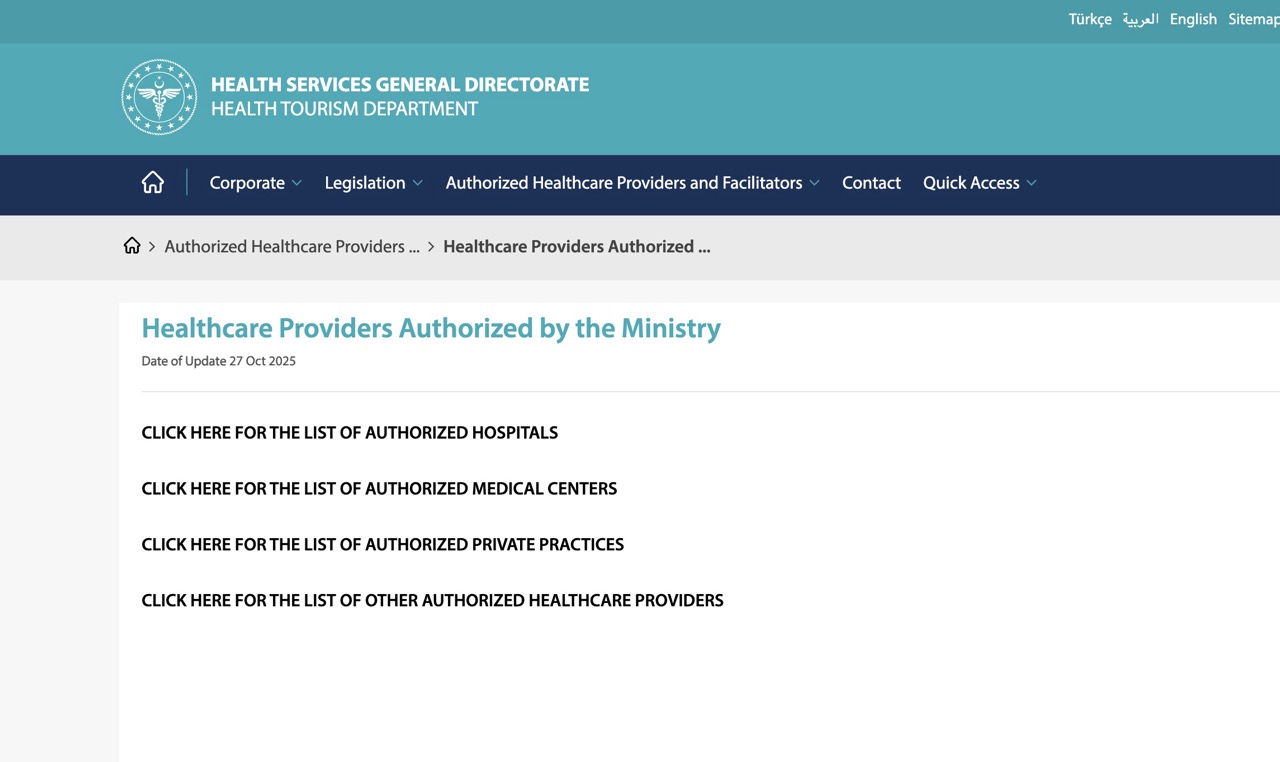
Research the surgeon, not just the brand
A real hair transplant is a surgical procedure. It’s not performed by coordinators, nurses, or technicians. Before booking:
- Ask for the full name of the operating doctor.
- Search their registration on the Turkish Medical Association.
Go to the official Ministry of Health “Health Professionals” database on healthturkiye.com, that this is where you can confirm hospitals, doctors, and clinics.
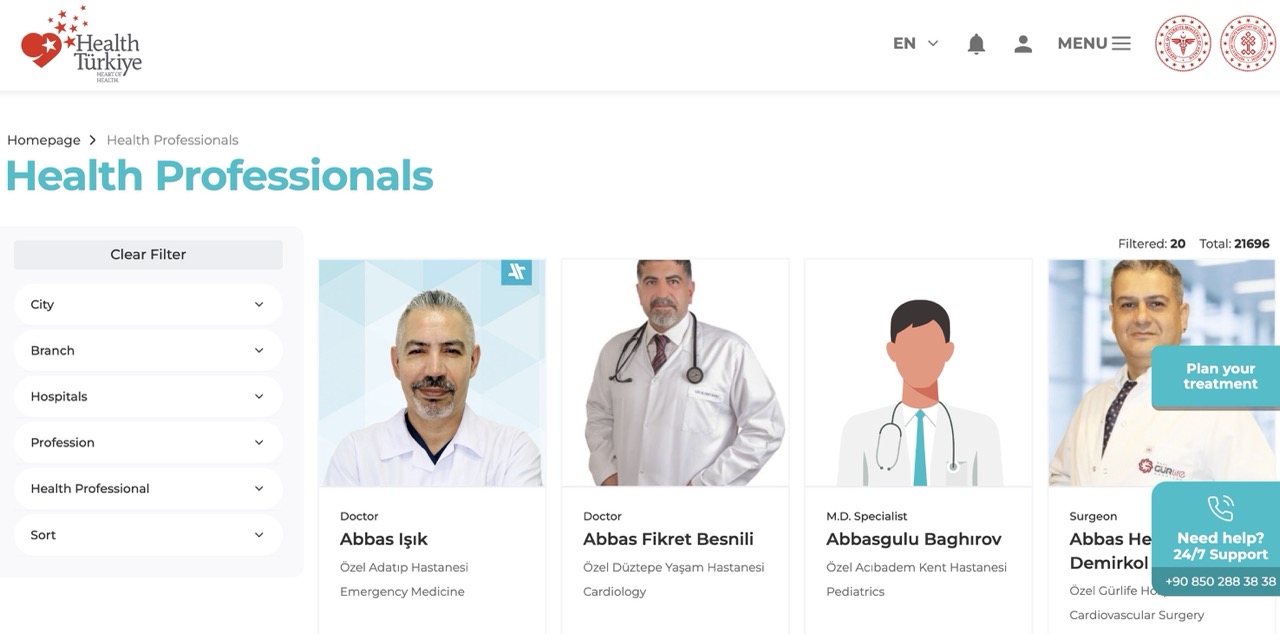
For “Facilitators with International Health Tourism Authorization Certificates”, find them on healthturkiye.com. It can be hard to search but you are getting familiar.
If the clinic avoids naming the surgeon or says, “our medical team handles it collectively”, stop there. According to ISHRS patient-safety guidelines, surgeon oversight from start to finish is non-negotiable.
Schedule a video consultation
This isn’t a sales chat. It’s where a doctor evaluates your hair loss pattern, donor area, and graft needs. Bring clear photos and medical history details (medications, allergies, blood pressure).
A real consultation includes:
- An estimate of grafts (never “unlimited”)
- The recommended technique (FUE, DHI, or Sapphire FUE)
- Expected recovery days and post-op plan
Clinics that quote you a price in 30 seconds based on a selfie aren’t doing medicine, they’re selling volume.
Once your clinic and surgeon check out, then it’s time to think flights, hotels, and that first Istanbul breakfast before surgery.
Step 2: Flights, Airports, and Where to Stay
Once your clinic is verified and your surgeon confirmed, it’s time to plan the trip itself. Getting these logistics right isn’t just about comfort, it directly affects how rested and ready you’ll be on surgery day. Istanbul can be a dream destination, but jet lag and poor timing can easily turn your big day into a blur.
Choosing the right airport
Istanbul has two major airports, and the one you pick can save you hours in transfers.
Istanbul Airport (IST)
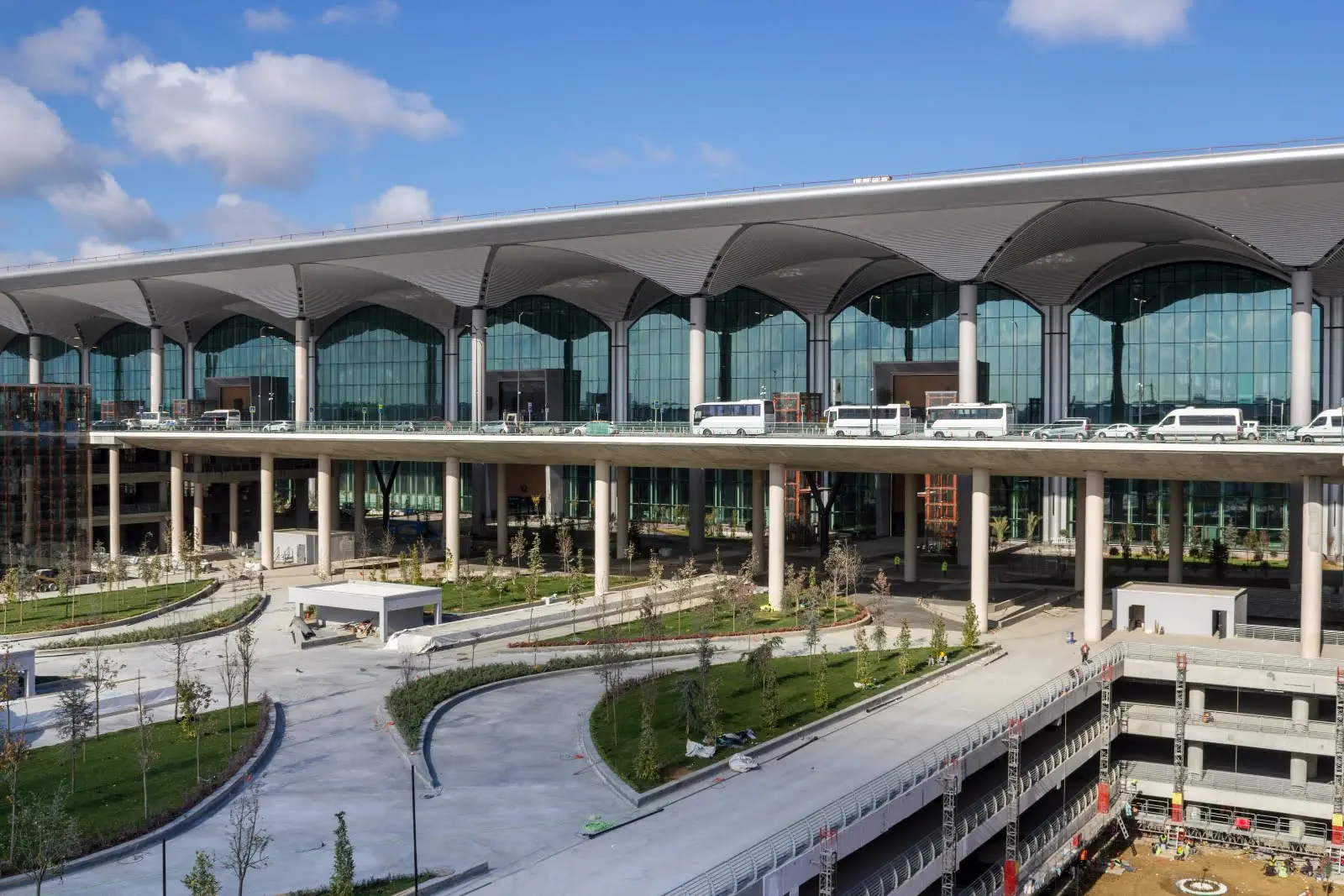
Located on the European side, Istanbul Airport (IST) is close to major clinic districts like Şişli, Nişantaşı, Beşiktaş Levent, and Taksim. It’s the main choice for most patients because 80% of top clinics are within a 30–40 minute drive.
Sabiha Gökçen Airport (SAW)
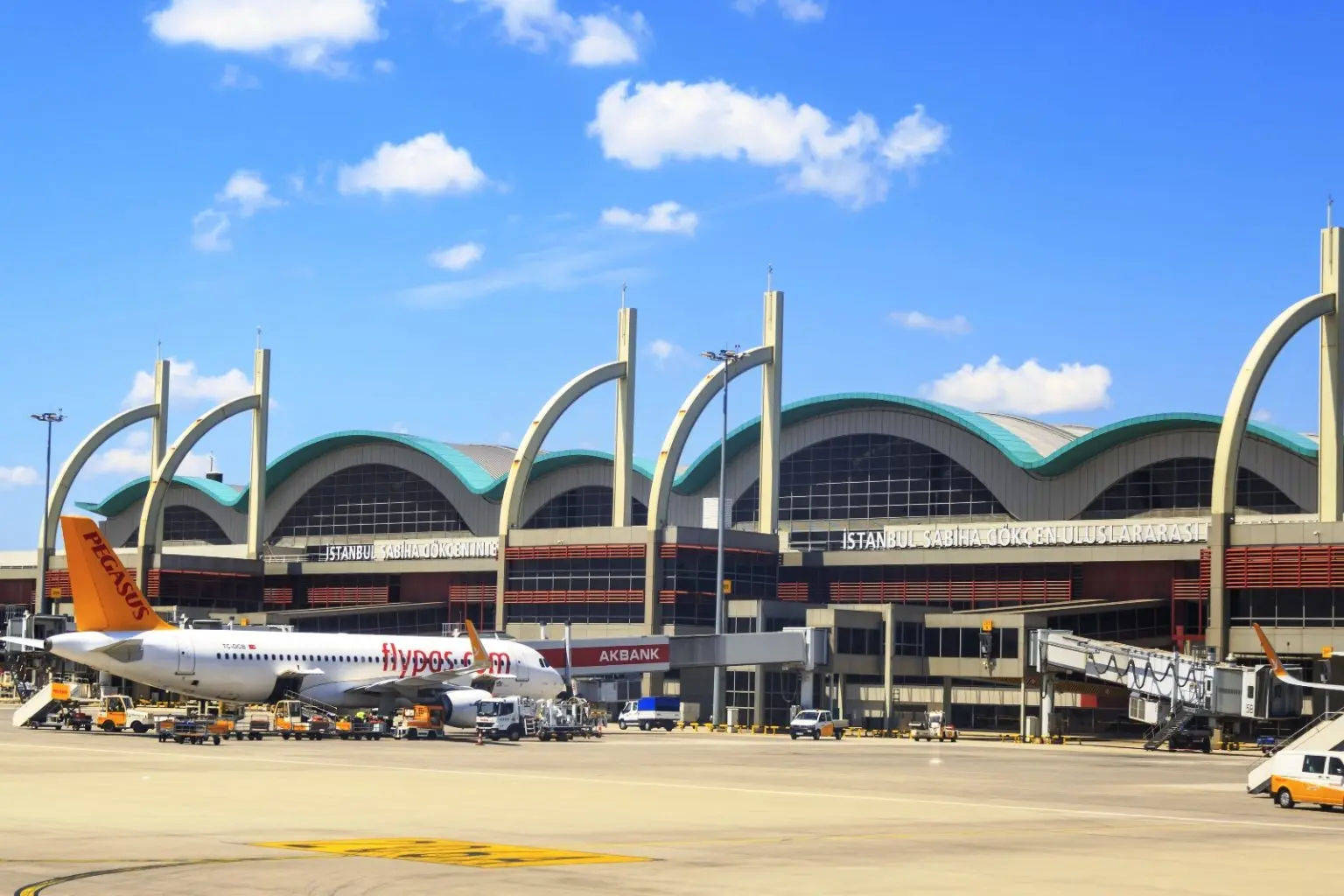
On the Asian side, Sabiha Gökçen Airport (SAW) is best if your clinic is in Kadıköy, Ataşehir, or Üsküdar. It’s smaller and often cheaper for low-cost airlines, but transfers to the European side can take over 90 minutes in traffic.
When to arrive and how long to stay
According to USHAŞ guidelines and the Turkish Health Tourism Association (THTC), the optimal visit for a hair transplant in Istanbul is 3 to 4 nights:
- Day 1: Arrival, rest, and (if needed) pre-op blood tests
- Day 2: Consultation + surgery
- Day 3: First wash and medical check
- Day 4: Recovery or light sightseeing before flight
Arriving at least one full day before surgery allows your body to recover from the flight and ensures all pre-op procedures (like ECG or blood tests) are done calmly and safely.
Where to stay
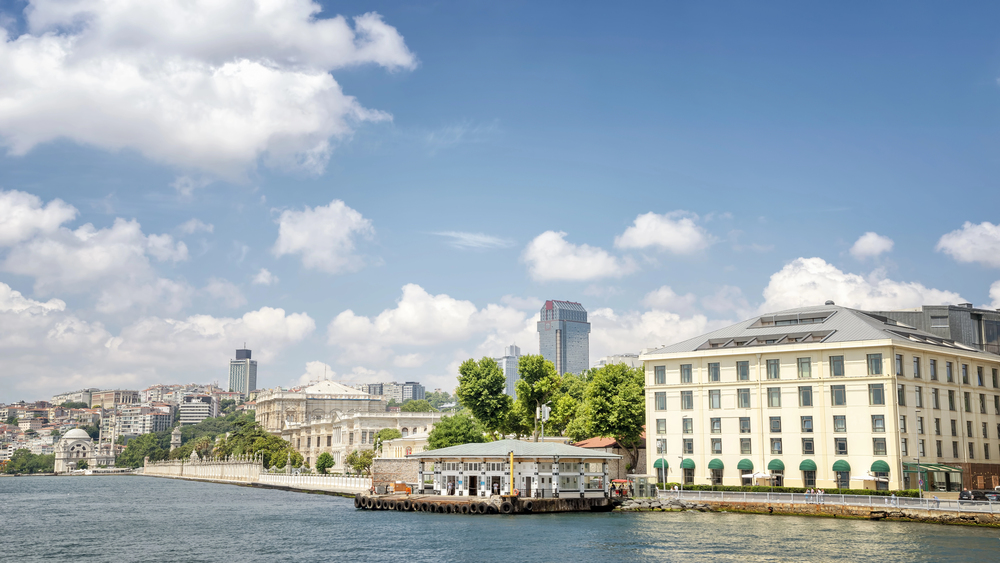
Most best hair transplant clinics in Istanbul offer all-inclusive packages that include hotel accommodation and airport transfers. But if you’re booking on your own, choose your area carefully:
- Nişantaşı / Şişli: Walking distance to many top clinics, central yet quiet.
- Beşiktaş: Lively, but close to reputable hospitals and easy to access IST.
- Kadıköy / Fenerbahçe: Perfect if your clinic is on the Asian side, calm and coastal.
Look for hotels with:
- Private bathrooms and daily housekeeping (important for hygiene)
- Breakfast service (you’ll be on medication and need easy meals)
- Quiet rooms for upright sleeping
Dr. Gökhan Bilgin: “The night before surgery, your best medicine is rest. A calm hotel 10 minutes from your clinic beats a fancy one across town.”
Step 3: Your 3–4 Day Itinerary
Knowing what to expect each day removes half the anxiety patients feel when flying to Turkey for a hair transplant. The rhythm is fast but well-structured, Istanbul’s licensed clinics run like clockwork, especially those accredited by the Turkish Ministry of Health and USHAŞ.
Day 1 — Arrival & Rest
You’ll land at either Istanbul Airport (IST) or Sabiha Gökçen (SAW), where a clinic driver usually meets you at the gate. Most packages include airport-hotel transfer, and you’ll check into your accommodation by evening.
Eat something light, hydrate, and sleep early. Your body needs to recover from travel stress before anesthesia and blood draw. Avoid caffeine, alcohol, or smoking, they affect circulation and graft healing.
Day 2 — Consultation & Surgery Day
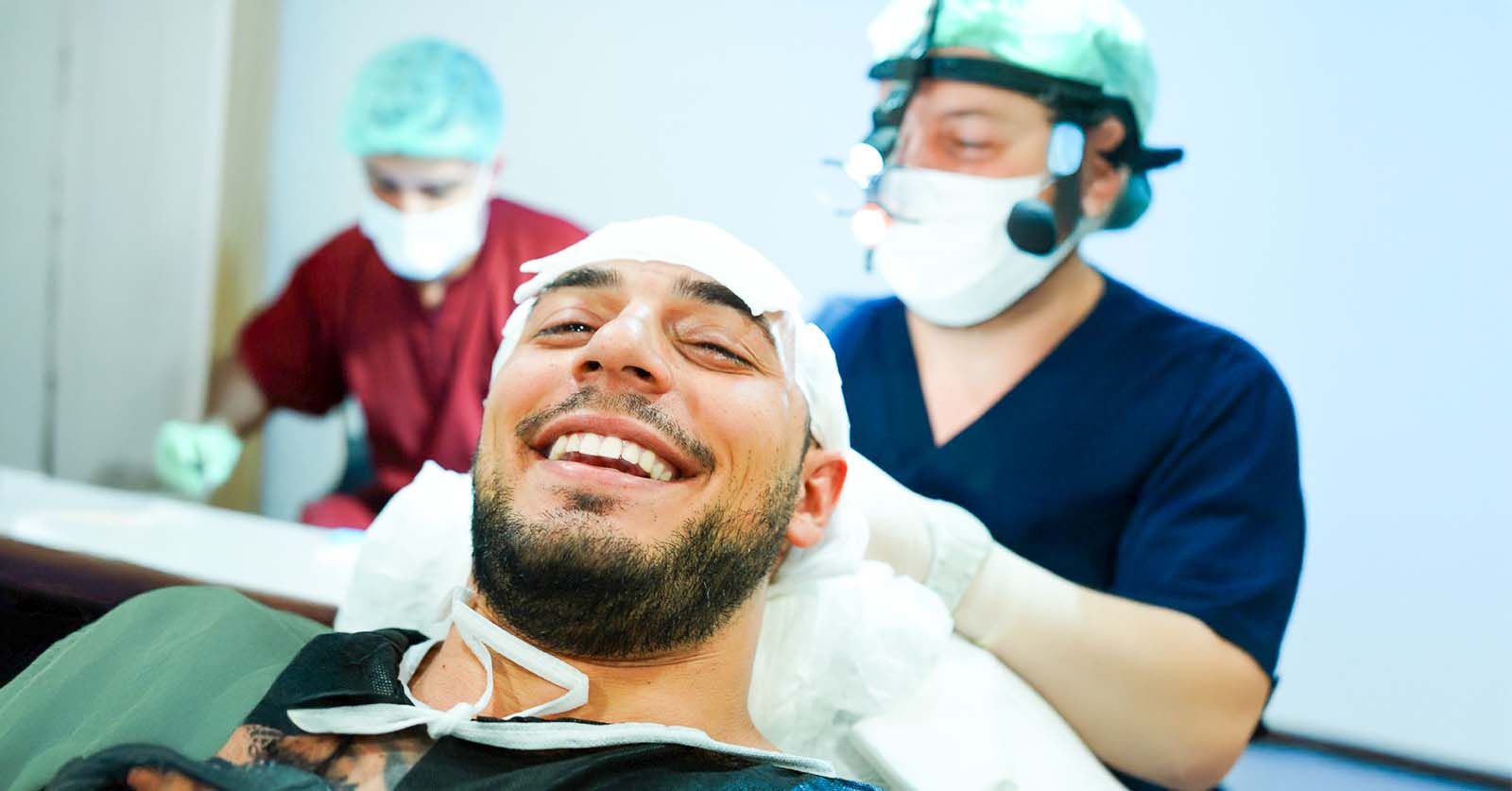
Morning starts with your in-person consultation. The surgeon examines your donor and recipient areas, finalizes the hairline design, and explains the technique (FUE, Sapphire FUE, or DHI) depending on your needs.
Then come:
- Pre-op tests (bloodwork, sometimes ECG).
- Local anesthesia and hair shaving.
- Extraction and implantation, lasting 5 to 8 hours depending on graft count.
You’ll rest at the clinic lounge afterward. Most centers provide a light meal and post-op meds before sending you back to the hotel.
Your head will be bandaged around the donor zone; avoid touching or bending forward for 48 hours.
Day 3 — First Wash & Post-Op Check
This is the most delicate phase. You’ll return to the clinic for your first hair wash, done by medical staff using foam shampoo and saline solution, no direct water pressure.
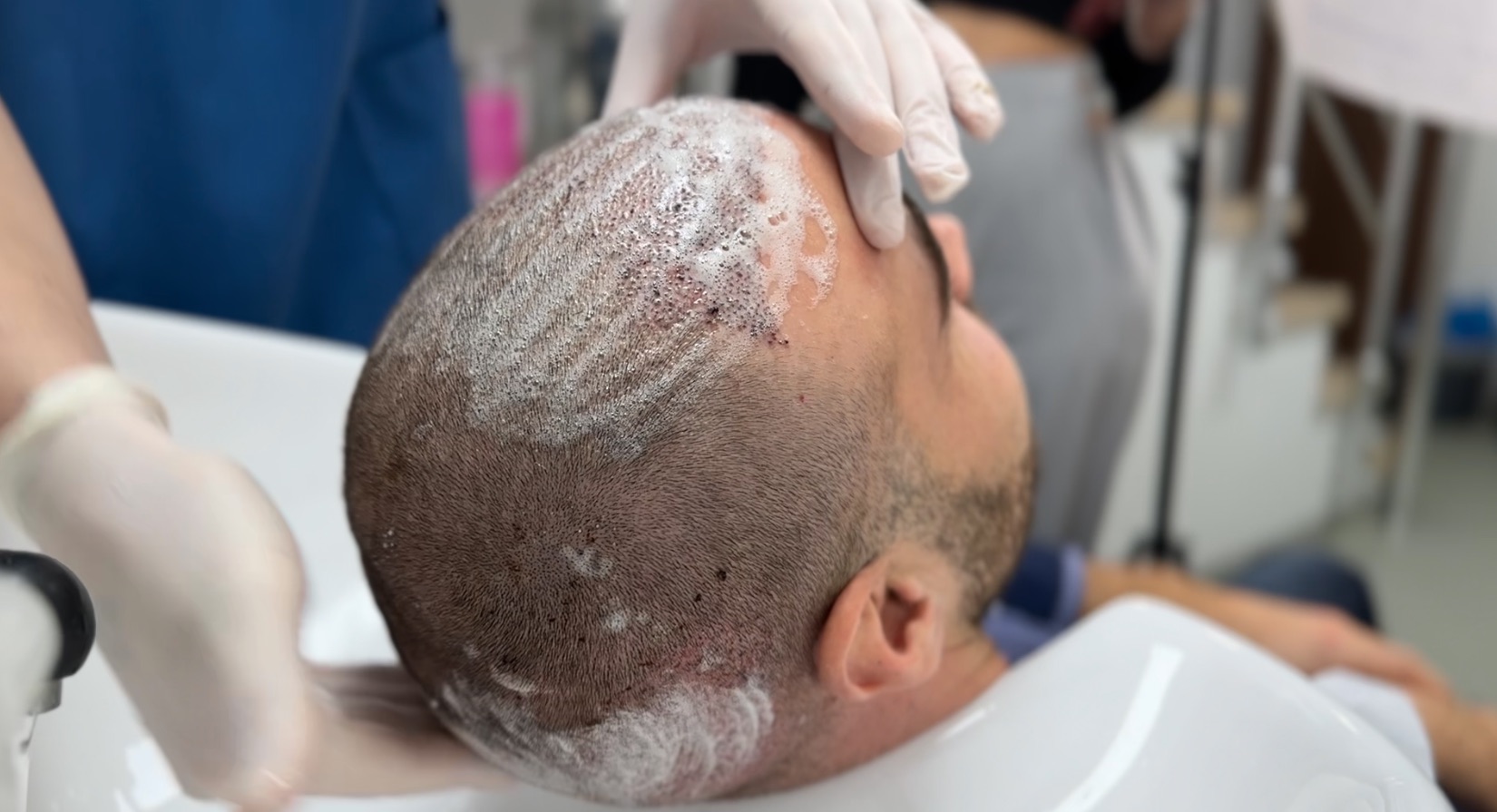
The doctor checks the grafts, removes dressings, and shows you how to wash gently at home. You’ll also receive:
- Aftercare kit (foam shampoo, saline spray, antibiotics, neck pillow)
- 24/7 emergency contact for your recovery week
According to Healthline and ISHRS guidelines, the first wash within 48–72 hours is vital for graft hygiene and crust management.
Day 4 — Recovery & Optional Sightseeing
By now, swelling is mild and discomfort is manageable. You can enjoy short outdoor walks or a slow coffee in nearby neighborhoods like Nişantaşı, Moda, or Karaköy are great low-traffic options.
Avoid crowds, direct sunlight, and public transport during rush hours. If flying home, clinics usually recommend waiting 48–72 hours post-surgery before boarding.
Pack loose clothing (no pullovers) and use your neck pillow for flight comfort.
The schedule is tight, but efficient, and it’s designed for international patients who want reliable medical care and minimal downtime.
Step 4: Smart Packing List (With Medical Reasons)
The right clothes, tools, and travel habits can literally protect your grafts and reduce infection risk. Most first-timers bring too much of the wrong stuff and forget the essentials that make the first few days comfortable.
Clothing
Bring clothes that don’t touch your scalp or require pulling over your head.
- Button-down shirts or zip-up hoodies: You’ll change clothes without disturbing grafts.
- Loose cotton T-shirts: For lounging after surgery.
- Soft tracksuit or pajama pants: You’ll spend a lot of time resting upright.
- Slip-on shoes: No bending or pressure on your scalp when tying laces.
Avoid tight collars, heavy fabrics, and wool hats, they trap heat and increase sweat, which can irritate your scalp during healing.
Medical & Hygiene Essentials
Your clinic will provide most aftercare items, but bringing a few extras helps, especially if you have allergies or sensitive skin.
- Neck pillow: Keeps your head elevated 30–45° while sleeping.
- Saline spray: Keeps grafts hydrated during flights and hotel stays.
- Disposable towels: More hygienic for early washes.
- Travel-size disinfectant wipes: For hotel surfaces and phone screens.
- Pain relief tablets: Only use ones approved by your clinic (no blood thinners).
According to Healthline and NHS travel health guidelines, keeping the surgical area clean and avoiding bacterial exposure in the first 72 hours drastically reduces infection risk.
Documents & Digital Backups
Don’t forget the paperwork, this is your medical trip, not just a holiday.
- Passport + travel insurance covering medical procedures
- Printed or digital clinic contract and payment receipts
- Doctor’s name, license number, and emergency contact
- Return flight confirmation (many clinics ask for this pre-op)
Snap photos of all documents and upload them to your email or cloud before departure.
What Not to Bring
- Tight hats or beanies (until day 10)
- Hair gel, sprays, or perfume near the scalp
- Electric shavers (clinic staff will handle trimming)
- Neck scarves or anything rubbing the donor area
Optional but Helpful
- Cooling gel mask (for mild swelling around eyes)
- Soft microfiber towel for washing at home
- Loose cotton pillow cover to prevent sticking
Step 5: Flight-Home Rules and Activity Windows
Most patients underestimate how sensitive those first few post-op days are. The surgery may be done, but your scalp is still in healing mode, every movement, every bump against a headrest matters. Getting your flight timing and early-day habits right makes all the difference between smooth healing and preventable setbacks.
When it’s safe to fly home
Licensed Turkish clinics and USHAŞ guidelines recommend flying no earlier than 48–72 hours after surgery. By then, swelling begins to subside, bleeding has stopped, and the grafts have settled into place.
- Day 1: Rest.
- Day 2: Surgery.
- Day 3: First wash and scalp check.
- Day 4: Safe to fly, ideally after a morning rest or short walk.
Shorter stays may seem convenient, but the first wash must be done by trained staff. Skipping that step is one of the biggest causes of infection among rushed travelers.
How to sit and sleep during flights
- Use your neck pillow and recline your seat only slightly.
- Avoid leaning the scalp against the headrest.
- If flying business or premium economy, choose the window seat for easier posture control.
- Keep a saline spray handy, cabin air dries grafts fast.
- Skip alcohol and caffeine; they worsen dehydration and swelling.
According to Healthline and NHS postoperative travel recommendations, upright posture and hydration are the two simplest ways to prevent complications after outpatient surgery.
Activity windows after arrival home
Recovery continues once you land:
- Days 1–10: No heavy lifting, gym, sauna, or swimming.
- Weeks 2–3: Light walks are fine; continue gentle washing daily.
- Weeks 4–6: You can resume gym or swimming once redness fades.
- Month 3: Full physical activity and sun exposure (with cap or sunscreen).
A study published in Journal of Cutaneous and Aesthetic Surgery showed that avoiding intense activity in the first 10 days increased graft survival by up to 15 percent, a figure most surgeons in Istanbul confirm from experience.
The takeaway? Treat those first 72 hours like a soft quarantine for your new hair. You only get one chance for those grafts to take root.
Step 6: What “All-Inclusive” Should Include (and What’s Extra)
The phrase “all-inclusive package” gets thrown around a lot in Istanbul’s hair-transplant ads. Some mean it, others use it as a sales hook. The goal here is to help you tell the difference before you click book now.
What a real all-inclusive package covers
Clinics certified by the Turkish Ministry of Health and authorized by USHAŞ must list every service provided to international patients. A legitimate package usually includes:
- Airport transfers (arrival & departure) – a private car or driver arranged by the clinic.
- Hotel accommodation – 3–4 nights in a partner hotel close to the clinic.
- Translation services – English-speaking coordinator available 24/7.
- Pre-operative tests – bloodwork, sometimes ECG.
- Surgery day – consultation, local anesthesia, procedure, post-op rest.
- Aftercare kit – foam shampoo, saline spray, medications, neck pillow.
- First wash at the clinic (usually Day 2 or 3).
- Follow-up for at least 6–12 months via WhatsApp or email.
According to the Turkish Health Tourism Association (THTC), over 80 % of international patients in 2024 chose clinics offering full-service coordination, transfers, lodging, and aftercare, because it simplifies logistics and lowers stress.
What’s not usually included (but often implied)
Here’s where some clinics blur the fine print. You might see “VIP” or “unlimited” language, but it rarely means what you think.
- PRP or exosome therapy – usually an optional add-on.
- Extra hotel nights – may add €70–€120 per night.
- Prescription medication refills – beyond the first week’s supply.
- Minoxidil/finasteride – offered separately.
- Tour or sightseeing options – never part of the medical package, even if advertised.
What to watch out for
If the package emphasizes a luxury hotel more than the surgeon’s name, it’s a marketing play. If it says “unlimited grafts”, it’s unsafe. And if the quote arrives in less than 60 seconds after you send a selfie, it’s not medical care.
Step 7: Light Sightseeing Ideas That Don’t Risk Grafts
If you’ve come all the way to Istanbul for your hair transplant, it’s natural to want to enjoy a little sightseeing between rest and recovery. The trick is knowing where you can go without putting your grafts in danger. No crowded bazaars, no sweaty ferries, no long sun exposure, but still plenty to see and feel.
Day 3–4: Soft walks, quiet corners
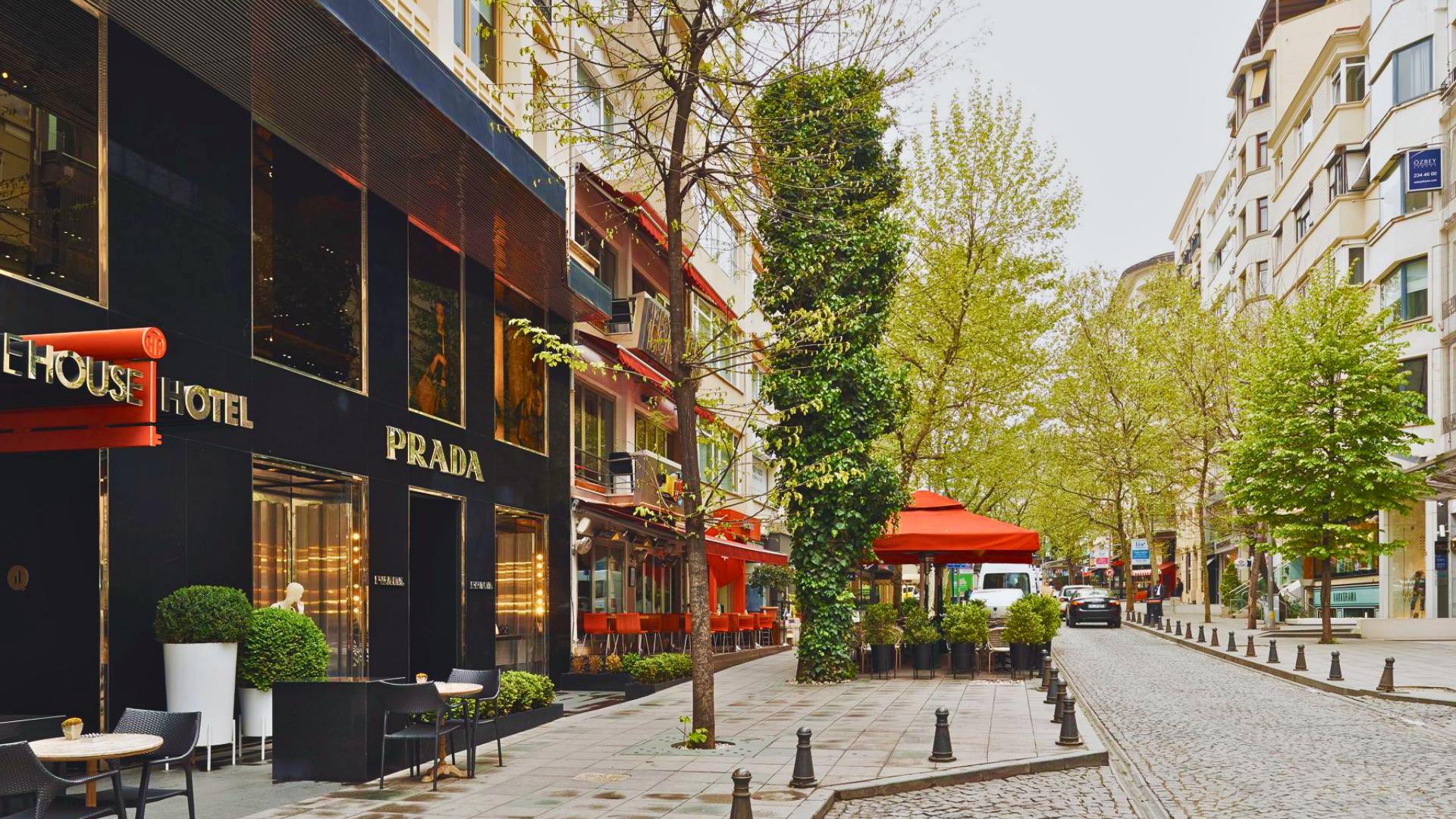
After your first wash, it’s safe to step outside for short strolls. Choose calm, shaded spots with gentle breezes and minimal crowding:
- Nişantaşı’s side streets — chic cafés, tree-lined avenues, and great people-watching from shaded patios.
- Karaköy waterfront — calm mornings with a sea breeze, perfect for a quiet breakfast.
- Moda (Kadıköy) — easy coastal walks and coffee stops away from tourist chaos.
Avoid the Grand Bazaar, Istiklal Street, or ferry decks at peak hours, accidental bumps or sun exposure can harm your grafts.
Safe activities you can enjoy
- Bosporus view cafés — shaded terraces where you can rest upright.
- Museum visits — Istanbul Modern or Sakıp Sabancı Museum offer calm, air-conditioned environments.
- Short sunset cruise (covered decks) — safe after Day 4 if your scalp is protected from wind and sun.
You’ll still feel part of the city, hearing the ferry horns, smelling roasted chestnuts, without breaking recovery rules.
What to avoid for at least 10–14 days
- Turkish baths (hamam) — heat, steam, and humidity are risky.
- Gyms and swimming pools — bacterial exposure.
- Full-day tours or long drives — too tiring and hard to maintain head position.
- Direct sun or uncovered rooftops — scalp sensitivity peaks early on.
According to Healthline and NHS postoperative guidance, keeping body temperature stable and avoiding UV exposure helps maintain graft survival rates above 90–95%, which aligns with ISHRS safety data for early healing.
Step 8: Red Flags That Ruin Trips
Turkey’s hair transplant scene is full of success stories, but it’s also where some travelers stumble into “too good to be true” deals. The problem isn’t Turkey itself. It’s the handful of unlicensed operators who trade speed and volume for medical safety. Knowing the red flags and potential scams before you travel can save your money, time, and hairline.
Clinics without a named surgeon
If a clinic won’t clearly state who performs the operation, walk away. Anonymous or “team surgery” models usually mean technicians are performing most of the procedure, which is illegal under the Turkish Ministry of Health.
Unrealistic pricing or “limited-time” deals
A full FUE or DHI surgery performed by a licensed doctor rarely costs less than $1,500–$1,700 USD in Turkey. Anything significantly lower often skips key safety steps, blood tests, sterile environment, or doctor involvement. Avoid “book before Friday” discounts or “VIP for 500 grafts free” promos. Medicine isn’t a flash sale.
“Unlimited grafts” or unclear graft counts
There’s no such thing as unlimited grafts. The donor area naturally limits what can be extracted safely. Overharvesting leads to permanent bald spots or patchy density. The American Academy of Dermatology (AAD) warns against clinics that promise extreme density in a single session, it’s physiologically impossible without harming your donor supply.
No post-op communication
If a clinic’s WhatsApp line goes silent after surgery, that’s a red flag. Certified centers must maintain follow-up access for at least one year after treatment. A clinic that vanishes after your flight home was never a medical provider, it was a transaction.
Overcrowded “hair mills”
Some unlicensed centers perform 20–30 surgeries a day, rotating patients through shared operating rooms. Watch for photos showing crowded halls or “technicians in matching uniforms”.
Missing paperwork
Before your flight, request a copy of your signed treatment plan, and it must include the clinic’s license number, surgeon’s name, estimated grafts, and aftercare policy. If they tell you “we’ll handle it when you arrive”, that’s a serious warning sign.
Step 9: After You Leave — Remote Follow-Ups and Who Helps If Something Goes Wrong
A good clinic doesn’t stop caring when you leave Istanbul. In fact, the most reliable ones get more involved once you’re home. They track your photos, guide your washing technique, and answer questions months later.
How proper follow-ups work
Every licensed clinic under the Turkish Ministry of Health and USHAŞ must provide ongoing support for international patients. This usually includes:
- Photo check-ins at 1, 3, 6, and 12 months.
- Remote consultations with the surgeon or medical coordinator.
- Advice on medications such as minoxidil, finasteride, or PRP maintenance.
- Digital records of your surgery and aftercare.
You’ll typically use WhatsApp, email, or a dedicated app. The goal isn’t just reassurance, it’s medical monitoring. If redness, pimples, or shock loss appear, your clinic should respond within 24 hours.
What if your clinic goes silent?
If messages go unanswered or staff disappear, keep everything: contracts, payment receipts, chats, and progress photos. You have official channels that can step in.
- USHAŞ International Patient Portal – accepts complaints from foreign patients and contacts the facility directly.
- Provincial Health Directorate – handles licensing violations or malpractice claims.
- Turkish Health Ministry Communication Center (SABİM 184) – 24/7 phone line for medical complaints within Turkey.
How long should support last?
At least 12 months, ideally up to 18 months. Hair growth continues well into the second year, so follow-ups matter for evaluating density and long-term donor health.
Step 10: Travel Checklist
Here’s the checklist our Istanbeautiful team built after years of visiting clinics, talking to surgeons, and helping travelers organize smoother trips for their hair transplant in Turkey. Print it, screenshot it, or save it to your phone, it keeps you focused from booking to boarding.
Before You Fly
- Verify clinic’s Ministry of Health license and USHAŞ certificate.
- Confirm the surgeon’s full name and registration number.
- Receive your written treatment plan (technique, graft count, price, aftercare).
- Schedule a video consultation and review your medical history.
- Book flights to the correct airport (IST or SAW).
- Reserve at least 3–4 nights in Istanbul, arrive a day before surgery.
- Pack button-down shirts, neck pillow, saline spray, and personal meds.
- Keep contracts, receipts, and passport scans saved digitally.
During Your Stay
Day 1: Arrive → Rest → Hydrate → Sleep early.
Day 2: Consultation → Hairline design → Surgery → Post-op rest.
Day 3: First wash at clinic → Receive aftercare kit → Learn washing steps.
Day 4: Light stroll or rest → Fly home after 48–72 hours.
Keep grafts untouched, avoid bending forward, alcohol, and smoking.
After You Leave Turkey
- Send photos at 1, 3, 6, 12 months.
- Stay in contact with your clinic via WhatsApp or email.
- Use only medications approved by your surgeon.
- Continue gentle washing until Day 10; resume activity slowly.
- Keep receipts and records for USHAŞ or Ministry contact if needed.